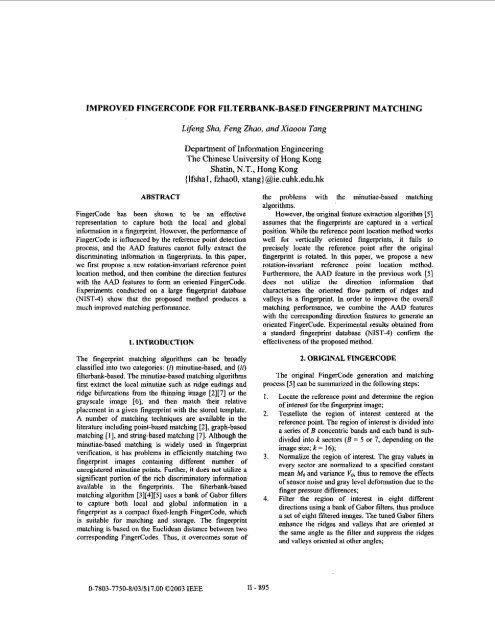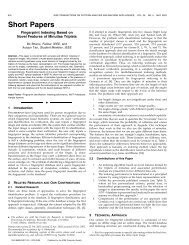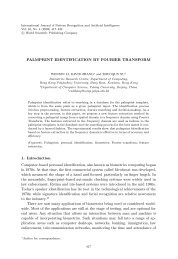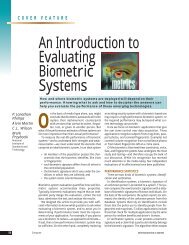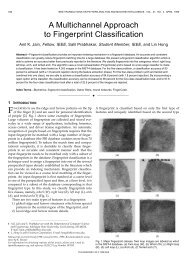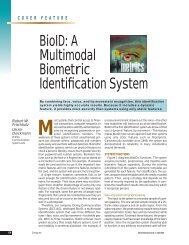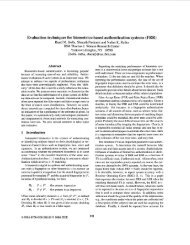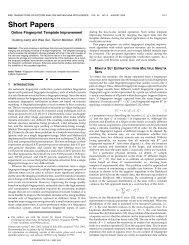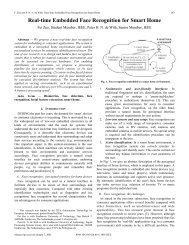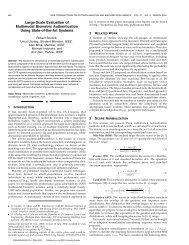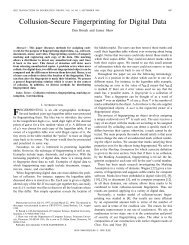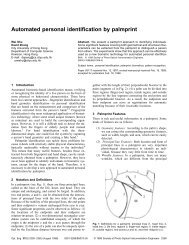Improved fingercode for filterbank-based fingerprint matching ...
Improved fingercode for filterbank-based fingerprint matching ...
Improved fingercode for filterbank-based fingerprint matching ...
You also want an ePaper? Increase the reach of your titles
YUMPU automatically turns print PDFs into web optimized ePapers that Google loves.
IMPROVED FINGERCODE FOR FILTERBANK-BASED FINGERPRINT MATCHING<br />
Lifeng Sha, Feng Zhao, and Xiaoou Tang<br />
Department of In<strong>for</strong>mation Engineering<br />
The Chinese University of Hong Kong<br />
Shatin, N.T., Hong Kong<br />
{Ifshal, fzhao0, xtang}@ie.cuhk.edu.hk<br />
ABSTRACT<br />
FingerCode has been shown to be an effective<br />
representation to capture both the local and global<br />
in<strong>for</strong>mation in a <strong>fingerprint</strong>. However, the per<strong>for</strong>mance of<br />
FingerCode is influenced by the reference point detection<br />
process, and the AAI) features cannot fully extract the<br />
discriminating in<strong>for</strong>mation in <strong>fingerprint</strong>s. In this paper,<br />
we first propose a new rotation-invariant reference point<br />
location method, and then combine the direction features<br />
with the AAD features to <strong>for</strong>m an oriented FingerCode.<br />
Experiments conducted on a large <strong>fingerprint</strong> database<br />
(NIST-4) show that the proposed method produces a<br />
much improved <strong>matching</strong> per<strong>for</strong>mance.<br />
1. INTRODUCTION<br />
The <strong>fingerprint</strong> <strong>matching</strong> algorithms can be broadly<br />
classified into two categories: (i) minutiae-<strong>based</strong>, and (ill<br />
<strong>filterbank</strong>-<strong>based</strong>. The minutiae-<strong>based</strong> <strong>matching</strong> algorithms<br />
first extract the local minutiae such as ridge endings and<br />
ridge bifurcations from tbe thinning image [2][7] or the<br />
grayscale image [6], and then match their relative<br />
placement in a given <strong>fingerprint</strong> with the stored template.<br />
A number of <strong>matching</strong> techniques are available in the<br />
literature including point-<strong>based</strong> <strong>matching</strong> [Zl,graph-<strong>based</strong><br />
<strong>matching</strong> [I], and string-<strong>based</strong> <strong>matching</strong> [7]. Although the<br />
minutiae-<strong>based</strong> <strong>matching</strong> is widely used in <strong>fingerprint</strong><br />
verification, it has problems in efficiently <strong>matching</strong> two<br />
<strong>fingerprint</strong> images containing different number of<br />
unregistered minutiae points. Further, it does not utilize a<br />
significant portion of the rich discriminatory in<strong>for</strong>mation<br />
available in the <strong>fingerprint</strong>s. The filterhank-<strong>based</strong><br />
<strong>matching</strong> algorithm [3][4][5] uses a bank of Gabor filters<br />
to capture both local and global in<strong>for</strong>mation in a<br />
<strong>fingerprint</strong> as a compact fixed-length FingerCode, which<br />
is suitable <strong>for</strong> <strong>matching</strong> and storage. The <strong>fingerprint</strong><br />
<strong>matching</strong> is <strong>based</strong> on the Euclidean distance between two<br />
corresponding FingerCodes. Thus, it overcomes some of<br />
the problems with the minutiae-<strong>based</strong> <strong>matching</strong><br />
algorithms.<br />
However, the original feature extraction algoritbm [5]<br />
assumes that the <strong>fingerprint</strong>s are captured in a vertical<br />
position. While the reference point location method works<br />
well <strong>for</strong> vertically oriented <strong>fingerprint</strong>s, it fails to<br />
precisely locate the reference point after the original<br />
<strong>fingerprint</strong> is rotated. In this paper, we propose a new<br />
rotation-invariant reference point location method.<br />
Furthermore, the AAD feature in the previous work [SI<br />
does not utilize the direction in<strong>for</strong>mation that<br />
characterizes the oriented flow pattem of ridges and<br />
valleys in a <strong>fingerprint</strong>. In order to improve the overall<br />
<strong>matching</strong> per<strong>for</strong>mance, we combine the AAD features<br />
with the corresponding direction features to generate an<br />
oriented FingerCode. Experimental results obtained from<br />
a standard <strong>fingerprint</strong> database (NIST-4) confirm the<br />
effecliveness of the proposed method.<br />
2. ORIGINAL FINGERCODE<br />
The original FingerCode generation and <strong>matching</strong><br />
process [5] can be summarized in the following steps:<br />
Locate the reference point and determine the region<br />
of interest <strong>for</strong> the <strong>fingerprint</strong> image;<br />
Tessellate the region of interest centered at the<br />
reference point. The region of interest is divided into<br />
a series of B concentric hands and each band is suhdivided<br />
into k sectors (5 = 5 or 7, depending on the<br />
image size; k = 16);<br />
Normalize the region of interest. The gray values in<br />
every sector are normalized to a specified constant<br />
mean MO and variance V,, thus to remove the effects<br />
of sensor noise and gray level de<strong>for</strong>mation due to the<br />
finger pressure differences;<br />
Filter the region of interest in eight different<br />
directions using a bank of Gabor filters, thus produce<br />
a set of eight filtered images. The tuned Gabor filters<br />
enhance the ridges and valleys that are oriented at<br />
the same angle as the filler and suppress the ridges<br />
and valleys oriented at other angles;<br />
0-7803-7750-8/03/%17.0002003 IEEE I1 - 895
Compute the average absolute deviation from the<br />
mean (AAD) of gray values in each of the 80 sectors<br />
<strong>for</strong> every filtered image to <strong>for</strong>m the Fingercode;<br />
Rotate the features in the Fingeeode cyclically to<br />
generate five templates corresponding to five<br />
rotations (MY,*22.5', 0") of the original <strong>fingerprint</strong><br />
image, thus to approximate the rotation-invariance;<br />
Rotate the original <strong>fingerprint</strong> image by an angle of<br />
11.25" and generate its FingerCode. Another five<br />
templates corresponding to five rotations are<br />
generated in the same way as Step 6;<br />
Match the Fingercode of the input <strong>fingerprint</strong> with<br />
each of the ten templates stored in the database to<br />
obtain ten <strong>matching</strong> scores. The final <strong>matching</strong> score<br />
is the minimum of the ten <strong>matching</strong> scores, which<br />
corresponds to the best <strong>matching</strong> of the two<br />
<strong>fingerprint</strong>s.<br />
3. REFERENCE POINT LOCATION<br />
The reference point is the center of the region of interest.<br />
Locating the reference point is an essential step that can<br />
influence the <strong>matching</strong> accuracy. The reference point<br />
detection algorithm developed in [5] has been shown to be<br />
more effective than most previous methods. However, we<br />
find that it is sensitive to <strong>fingerprint</strong> rotation. In this work,<br />
we develop a new reference point location algorithm that<br />
is rotation invariant. Our reference point location<br />
algorithm includes the following steps:<br />
of the line Mj2 as the reference point; otherwise, we<br />
assign the coordinates of M, as the reference point.<br />
Figure 1. Region S is centered around pixel (i
is an even symmetric real-valued Gabor filter. It has the<br />
following general <strong>for</strong>m in the spatial domain:<br />
{ ;[;: ii; j}<br />
G(x,y;f,B)=exp -- i+-r cos(2gY) (I)<br />
x'= xsin0 + ycos0 (2)<br />
y'= xcos0 - ysin0 (3)<br />
where f is the frequency of the sinusoidal plane wave<br />
along the direction 0 with respect to the x-axis, and 8,. and<br />
8,. are the standard deviations of the Gaussian envelope<br />
along x'- and y '-axis, respectively. The <strong>filterbank</strong> consists<br />
of eight Gabor filters, each differing in orientation 0 only<br />
(f= 0.1, reverse of the average inter-ridge distance; S,., 8,.<br />
= 4.0, about half of the average inter-ridge distance.). The<br />
eight values of 6' are O", 22.5', 45', 67.5", 90", 112.5',<br />
135', and 157.5'. Thus, the filtering process produces a<br />
set of eight filtered images.<br />
Figure 4. Examples to illustrate the rotation-invariance of our<br />
algorithm (top row) compared with the algorithm in [5] (bottom<br />
row).<br />
Let F, (m = 0, 1, ,._, 7) be the mrh filtered image. We<br />
define a new 2-D feature vector <strong>for</strong> each sector si (i = 0, 1,<br />
..., 79) in F,,, as V,. The magnitude value of V, is the<br />
average absolute deviation from the. mean (AAD) as<br />
defined in [5]; and the angle of V, is the dominant local<br />
ridge direction in sector si. The features in all the sectom<br />
constitute a sub-Fingercode <strong>for</strong> the filtered image F,. The<br />
collection of all the eight sub-Fingercodes is defined as<br />
the oriented Fingercode. Similar to [5], to approximate<br />
the rotation invariance, we cyclically rotate the features<br />
and the image to generate ten templates. The <strong>matching</strong> is<br />
<strong>based</strong> on the Euclidean distance between two<br />
corresponding FingerCodes. Let Vjm and Vjm represent the<br />
vector features <strong>for</strong> the two corresponding seclors in the<br />
m,h sub-FingerCode. Then, the Euclidean distance<br />
between two FingerCodes is defined as follows:<br />
7 79<br />
ED=CC1Y, -vjml<br />
m=oi.j=o<br />
Figure 3. Reference point location results of the <strong>fingerprint</strong> pairs<br />
of different quality. (Top row: <strong>fingerprint</strong> pairs of high quality;<br />
middle row: <strong>fingerprint</strong> pairs of moderate quality; bottom row:<br />
<strong>fingerprint</strong> pairs of poor quality.)<br />
Note that there is an ambiguity of II in the local ridge<br />
direction, i.e., local ridges oriented at d4 and 544 cannot<br />
be differentiated from each other. If the intersecting angle<br />
between Vi, and 5, is larger than ninety degrees, we<br />
reverse one of them to obtain a smaller distance.<br />
Experimental results show that using the oriented<br />
FingerCode gives a better per<strong>for</strong>mance than using AAD<br />
features only. Since the local ridge direction in<strong>for</strong>mation<br />
is computed at the reference point location stage, the<br />
addition of the local ridge direction as a new feature will<br />
have almost no effect on the <strong>matching</strong> time.<br />
11 - 897
5. EXPERIMENTS<br />
Experiments are conducted on a standard <strong>fingerprint</strong><br />
database NIST-4, which contains a set of 2000 <strong>fingerprint</strong><br />
image pairs (512x512, 256 gray levels, 500 dpi). Each<br />
<strong>fingerprint</strong> pair has two different rolled impressions of the<br />
same finger. We remove some <strong>fingerprint</strong>s if their<br />
reference points are too close to the edge of the image.<br />
To test the per<strong>for</strong>mance of the oriented Fingercode,<br />
we first implement a <strong>filterbank</strong>-<strong>based</strong> <strong>fingerprint</strong> <strong>matching</strong><br />
system using the original approach [5]. Here, we replace<br />
the reference point location algorithm with the new<br />
algorithm discussed in Section 3. The dataset is then<br />
processed using the implemented system.<br />
We then replace the FingerCode generation module<br />
with the new algorithm to compute the oriented<br />
FingerCode. The same dataset is again processed. Each<br />
test <strong>fingerprint</strong> image is matched with all the other<br />
<strong>fingerprint</strong>s in the database. If the Euclidean distance<br />
between two Fingercodes is helow a threshold, we make<br />
the decision that “the two <strong>fingerprint</strong> images are<br />
matched”; otherwise, we say, “the two <strong>fingerprint</strong> images<br />
come from different fingers”. The <strong>matching</strong> is labeled<br />
correct if the matched pair is from the same finger and<br />
incorrect, otherwise. The genuine acceptance rate (GAR)<br />
and the false acceptance rate (FAR) corresponding to a<br />
distance threshold are computed according to these<br />
labeled <strong>matching</strong> results. The overall <strong>matching</strong><br />
per<strong>for</strong>mance can be measured by a receiver operating<br />
characteristic (ROC) curve, which plots GAR against<br />
FAR at different operating points (distance thresholds).<br />
Each point on the curve corresponds to a special distance<br />
threshold. In the experiments, we use the Gabor filters<br />
with various f and a,., S,.. Figure 5 illustrates the<br />
per<strong>for</strong>mance improvement of the new approach. The<br />
dashed line represents the per<strong>for</strong>mance of the original<br />
approach [5], while the solid line shows the per<strong>for</strong>mance<br />
of the new approach. From the results, we can see that the<br />
new approach outper<strong>for</strong>ms the original approach over a<br />
wide range of FAR values, especially at low FAR values.<br />
6. CONCLUSION<br />
In this paper, we have presented an improved method <strong>for</strong><br />
filterhank-<strong>based</strong> <strong>fingerprint</strong> <strong>matching</strong>, which utilize both<br />
the AAD features and the direction features available in<br />
the <strong>fingerprint</strong>s. Experimental results obtained from a<br />
large <strong>fingerprint</strong> database (NIST-4) show that the addition<br />
of the direction features leads to a substantial<br />
improvement in the overall <strong>matching</strong> per<strong>for</strong>mance.<br />
Moreover, the proposed reference point location method<br />
is robust and rotation-invariant <strong>for</strong> <strong>fingerprint</strong> images.<br />
7. ACKNOWLEDGMENT<br />
The work described in this paper was fully supported by a<br />
grant from the Research Grants Council of the Hong<br />
Kong SAR (Project no. CUHK 4190101E).<br />
Figure 5. ROC curves comparing the per<strong>for</strong>mance of the new<br />
Fingeeode with the original Fingeeode on the NIST-4<br />
database.<br />
8. REFERENCES<br />
[I] A. K. Hrechak and I. A. Mchugh, “Automated <strong>fingerprint</strong><br />
recognition using stmcturai <strong>matching</strong>,” Parrern<br />
Recognition, vol. 23, no. 8, pp. 893-904, 1990.<br />
[2] A.K. lain, L. Hong, S. Pankanti, and R. Bolle, ” An<br />
identity authcntication system using <strong>fingerprint</strong>s”, Proc.<br />
E€€, Vol. 85,No. 9, pp. 1365-1388, 1997.<br />
[3] A. K. lain, S. Prabhakar, and L. Hong, “ A multichannel<br />
approach to <strong>fingerprint</strong> classification,” IEEE Trans.<br />
Pattern Anal Machine /nk?l/., vol. 21, no. 4, pp. 348-359,<br />
1999.<br />
14) A. K. lain, S. Prabhakar, L. Hong, and S, Pankanti,<br />
“Fingeeode: a <strong>filterbank</strong> <strong>for</strong> <strong>fingerprint</strong> representation and<br />
<strong>matching</strong>,” Proc. IEEE Computer Society Con/ Compurer<br />
Vision and Partern Recognirion(CVPR), vol. 2, pp. 187-<br />
193, 1999.<br />
[SI A. K. lain, S. Prabhakar, L. Hong, and S. Pankanti,<br />
“Filterbank-<strong>based</strong> <strong>fingerprint</strong> <strong>matching</strong>,” IEEE Trans.<br />
Image Processing., vol. 9, no. 5, pp. 846-859, 2000.<br />
161 D. Maio and D. Maltoni, “Direct gray-scale minutiae<br />
detection in <strong>fingerprint</strong>s,” IEEE Tram. Parrern Anol.<br />
Machine InreN., vol. 19 no. I , pp. 27-40, 1997.<br />
[7] N. Ratha, S. Chen, K. Kam, and A.K. lain, ” A real-time<br />
<strong>matching</strong> system <strong>for</strong> large <strong>fingerprint</strong> databases”, IEEE<br />
Tram Parrern Anal. Machine Iniell., vol. 18, no. 8, pp.<br />
799-813. 1996<br />
II - 898


